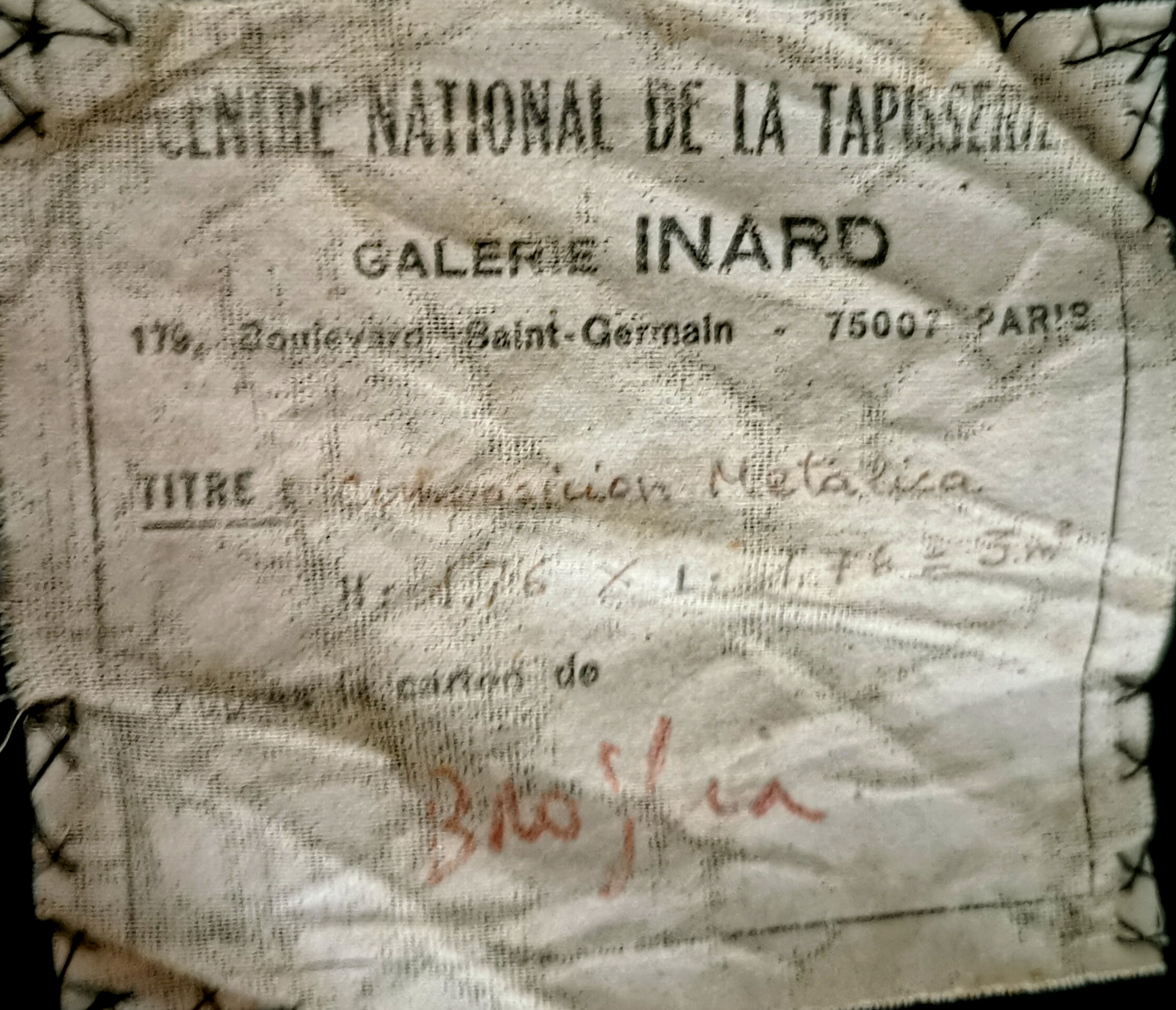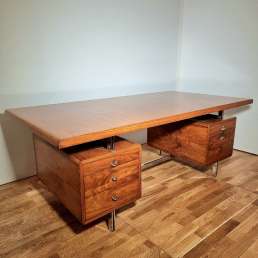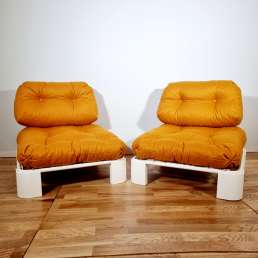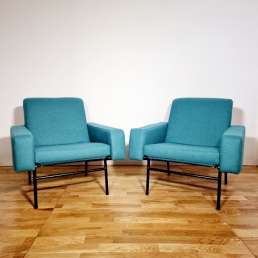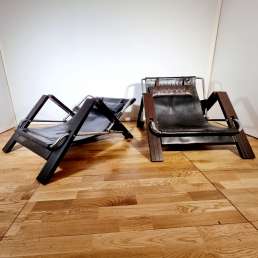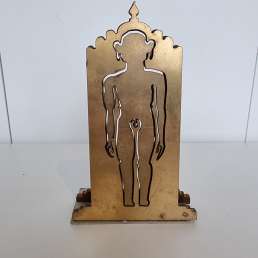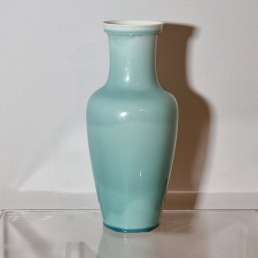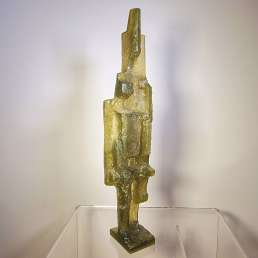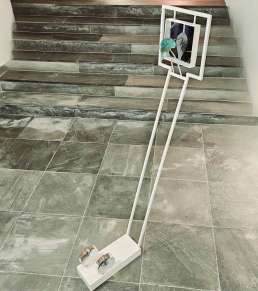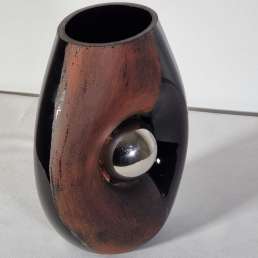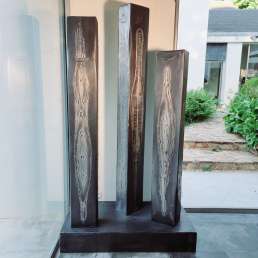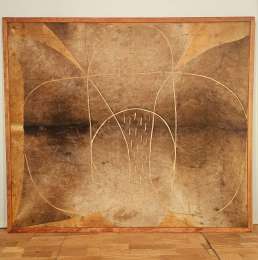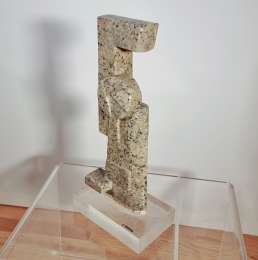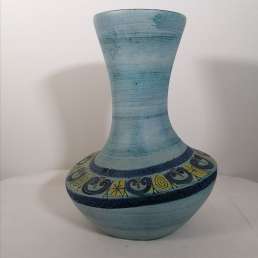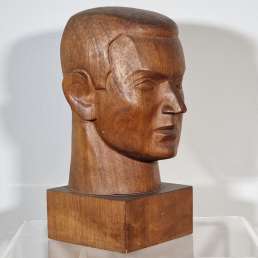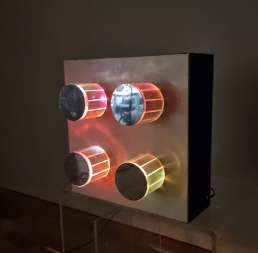Enrique Broglia, “Composicion metalica”, tapestry, circa 1970
Description
What I like
The tapestry “Composicion metalica” bears witness to the revival of tapestry in the 20th century: after the apotheosis of the works of Dom Robert, Picart Ledoux, Jean Lurçat, Marc Saint Saens, taking up the basics of the craft, with fewer colors more applied in flat areas , artists like Sheila Hicks gave it an electric shock: they integrated elements other than wool, cotton and silk, they questioned its flatness, they moved it in the middle of the pieces. The tapestry became a work of art and was practiced by artists who also have other means of expression: here, Broglia creates an opposition between the plane of the wool and that of the rectangular metal elements, between the light differently reflected by metal and wool. He does the work of a sculptor.
I like the idea of having a work of art in its own right, from an artist who left above all a monumental work. Moreover, Broglia is for me the archetype of all those South American artists who had to flee the dictatorships established in the sub-continent, to which France very often knew how to open its doors. Art, especially kinetic art, owes a lot to these artists hosted in France.
Technical description
Enrique BROGLIA (Uruguay, 1942-2013)
“Composition metalica”
Woolen tapestry with rectangular metal elements (probably brass) woven into the weft, monogrammed lower right.
Bolduc indicating: Centre National de la Tapisserie, Galerie Inard- 179, boulevard Saint Germain- Paris 7th, the title, dimensions and signature.
Circa 1970.
Dimensions and weight
Height: 176 cm- Width: 176 cm
Weight: 10 kg
Mix & Match
This tapestry is a work of art with a strong singularity: the mixture of copper metal with wool gives it all its cachet. Therefore, like any powerful work of art, it can be confronted with any type of furniture. Of course, we think of furniture by Eames, Warren Platner, Harry Bertoia, published by Mobilier International or Knoll. But this “Composition metalica” is perfectly adapted to respond to the rigor of the palette of Sonja Wasseur’s Grass Hopper armchairs; you can also wake it up with the peacock blue of our G10 armchairs by Pierre Guariche for Airborne, or why not dare to confront it with the orange fabric of our pair of white lacquered metal low chairs from the 1970s.
The large office of the Banque de France will offer the warmth of its walnut and the reflection of its chrome to highlight our beautiful tapestry. I think that in the same room, we can place the Pyramid lamp by A. Tonello and A. Montagna Grillo, with its cheeky chrome twist, or the large cylindrical lamp by Felice Antonio Botta, which combines the brown of its smoked Plexiglas and the chrome of its rings.
It’s not so easy to rub shoulders with such a particular tapestry: I nevertheless think that the cut-out gouache “Vers la joie” by Paul Shisaku Foujino and the bronze palette of “Africano N1, 1961” by Enrico Cervelli are sufficiently powerful works to support the comparison. .
In the same room as our tapestry, I will exhibit the monumental statue “Colonnes, 1966”, by Guillaume Leunens, which has another way of highlighting the plastic qualities of metal.
Finally, the chic side of our “Composition metalica” will suit 18th or 19th century furniture: both the patina of the gilded wood and the flames of the mahogany will be magnified by this tapestry.
In stock
Description
To know more
The artist
Enrique BROGLIA (Uruguay, 1942-2013)
Before he was 20, Broglia made a name for himself as a draftsman and won important prizes – the first most important, at the Salón Nacional de Bellas Artes in Uruguay in 1961 – which helped him to make of his passion for art his profession. The year 1965 is crucial for its future. It was then that Broglia extended its activity beyond Uruguay and appeared strongly on the international scene with an exhibition in New York (United States) and another in Porto Alegre (Brazil), as well as a tour in Europe. Three years later, he obtained a scholarship from the French government which allowed him to settle in Paris, while continuing to organize individual exhibitions throughout the world: sculpture, painting, drawing, engravings, lithographs.
He lived in Paris for several years, during which time the large sculptures that occupy various public spaces in France dominated. In the late 1970s, commissions for works by Broglia moved from Osaka University (Japan) to Europe (Belgium, Spain, Italy, Belgique) and the United States. In the 1980s, he moved to Alaro, (island of Majorca, Spain), where he lived and worked until 1996 with a production of sculptural works that would remain on the island, largely under the protection of the Fund of the Collecció d’Art Serra, but also with commissions for large events that will be distributed worldwide, such as the sculptures made for the 1998 Olympic Games in Seoul. Also at this time, he collaborated in the publication of El Baquiano y los suyos (with Mario Benedetti) and Vins i déus (the work of Father Antoni Serra Bauza for whom he made the lithographs).
Although he visited Uruguay occasionally and briefly during his years of residence in Spain and France, it was not until 1996 that he returned permanently to his country. His work, fundamentally sculptural and with important works in metal, is characterized by forms where the artist opposes opposites in a tension that generates complex sensations in whoever contemplates the work. But this tension ends up being resolved in a balance and “all its strength lies in the fairness” achieved by the artist. Antonio Urrutia pointed out that “all of Broglia’s work is imbued with the agonizing desire to manifest the combined counterpoint of the forces of good and evil”.
In France, Broglia’s monumental sculpted work can be seen in Reims (place created in 1971), Saint Cloud (1971), Viry-Châtillon (1971), Longjumeau (1977) and Nantes (1984).
In Spain we admire his creations at the Parc de la Mar, Pont d’Inca and Place de San Oliva, in Palma de Mallorca (1984), as well as his Tribute to Emigrants in Soller (1987), Center Commercial de Alcudia (1989) and at the Nautical Club of San Rapital (1995).
In Uruguay, at the Montevideo Shopping Center (1989), Rush Fountain (1996), high relief of the Rincon de las Artes promenade, Montevideo.
Many of Broglia’s works are in museums: Center Georges Pompidou, Paris; National Library, Paris; National Museum of Fine Arts, Uruguay, Ostend Museum, Belgium; Museum of Modern Art, Madrid, Spain; Seoul Olympic Museum, Korea, Osaka University, Japan; French Embassy, Brasilia, Brazil.
The editor
The Inard gallery, specialist in contemporary Aubusson tapestry, was created by Alain Inard, owner of several art galleries in Paris and Toulouse. She edited artists like Mario Prassinos, Robert Wogensky, Michel Degand or Giannesini. It experienced setbacks in 1993, the museum-foundation which was to open its doors in Toulouse having finally not seen the light of day.
A beautiful and authentic at a fair price
This work of art has been carefully selected for its aesthetic qualities, originality and fair price. Our choice favors above all the acuity of the design, and the quality of its manufacturing, guarantee of a valorization of your new acquisition in your interior and of an ability to dialogue with your furniture, to agree and to mix to create a unique decoration.
Buying a work of art from the 1970s is an investment linked to the appetite of many for the art of these years.
Buying a vintage work of art preserves the planet’s resources.







